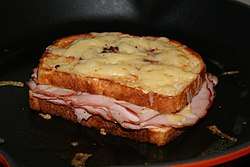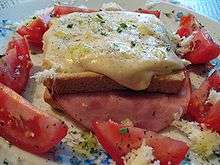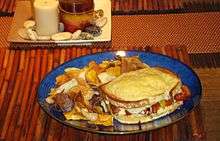Croque monsieur
A croque monsieur (French pronunciation: [kʁɔk məsjø]) is a hot sandwich made with ham and cheese. The dish originated in French cafés and bars as a quick snack. The name is based on the verb croquer ("to crunch") and the word monsieur ("mister"). The sandwich's first recorded appearance on a Paris café menu was in 1910.[1] Its earliest mention in literature appears to be in volume two of Proust's In Search of Lost Time in 1918.[2]
 A croque monsieur still in an oven after broiling | |
| Type | Sandwich |
|---|---|
| Place of origin | France |
| Serving temperature | Hot |
| Main ingredients | Bread, whipped eggs, butter, boiled ham, cheese (typically Emmental), pepper and salt |
| Variations | croque madame |
Preparation
A croque monsieur is traditionally made with baked or boiled ham and sliced cheese between slices of brioche-like pain de mie topped with grated cheese and slightly salted and peppered, which is baked in an oven or fried in a frying pan. Instead of the butter bread, the bread may optionally be browned by grilling after being dipped in beaten egg. Traditionally, Emmental or Gruyère is used, or sometimes Comté cheese as well. Some brasseries also add Béchamel sauce.
Croque monsieur may be baked or fried so that the cheese topping melts and forms a crust.[3][4] This may be done in a small horizontal grill designed for grilling sandwiches.
When dipped in egg batter and fried in butter, it is called a Monte Cristo sandwich.[5]
Variations
A croque monsieur served with a poached or lightly fried egg on top is known as a croque madame[6] (or, in parts of Normandy, as a croque-à-cheval). Many cooking and recipe sites, such as The New York Times Cooking and Food Network, attribute the name to the egg resembling an old fashioned woman's hat. According to the Petit Robert dictionary, the name dates to around 1960. The name croque-mademoiselle is associated with its lighter, vegetarian version: made of the same bread, but with ordinary melting cheese, accompanied with chives, cucumber and salad.[3]
A ham and cheese sandwich snack, very similar to the croque-monsieur, though not containing any béchamel or egg, is called a tosti in the Netherlands, and toast (pronounced "tost") in Italy and Greece. Similarly, in the United Kingdom, a ham-and-cheese hot snack is called a toastie, and toastie makers are available to buy. In the United States, the Monte Cristo, a ham-and-cheese sandwich, often dipped in egg and fried, is popular diner fare, and a 'grilled cheese sandwich' is a classic sandwich that has been enjoyed at home and in cafeteria-style restaurants since the Great Depression.[7]
Variants of the sandwich with substitutions or additional ingredients are given names modelled on the original croque-monsieur, for example:
| Name | Added ingredients | Reference |
|---|---|---|
| Barros jarpa | Variation from Chilean cuisine | [5] |
| Barros Luco | Made with roast beef instead of ham | [5] |
| Croque provençal | Tomato | [8] |
| Croque auvergnat | Bleu d'Auvergne cheese | [9] |
| Croque norvégien | Smoked salmon instead of ham | [5] |
| Croque tartiflette | Sliced potatoes and Reblochon cheese | [8] |
| Croque bolognese / croque Boum-Boum | Bolognese sauce) | |
| Croque señor | Tomato salsa | |
| Croque Hawaiian | Slice of pineapple | |
| Croque gagnet | Gouda cheese and andouille sausage | [10] |
| Croque Madame | Fried egg | [5] |
| Croque monsieur with bechamel | Standard croque monsieur topped with bechamel sauce | [5] |
| Francesinha | Variation from Portuguese cuisine with steak, sausage, ham, melted cheese and beer sauce | [5] |
The French chef Jacques Pepin also makes a version using chicken instead of ham,[11] which he demonstrated in the "Our Favorite Sandwiches"[12] episode on the PBS series (and its coordinating cookbook of the same title) Julia and Jacques Cooking at Home in which he worked with Julia Child.
 A croque madame
A croque madame A croque provençal
A croque provençal A croque gagnet
A croque gagnet
See also
Notes
References
- Montagné, Prosper; Charlotte Snyder Turgeon; Nina Froud (1961). Larousse Gastronomique. New York City: Crown Publishing Group. ISBN 0-517-50333-6. OCLC 413918.
- (in French) Entry in the on-line Trésor de la langue française.
- "Croque-monsieur et croque-madame font des enfants" (in French). aufimin cuisine suisse. 18 March 2009. Retrieved 21 August 2015.
- "Croque monsieur au four". Cuisine actuelle. Retrieved 21 August 2015.
- Russo, Susan. The Encyclopedia of Sandwiches.
- Dictionnaire général pour la maîtrise de la langue française, la culture classique et contemporaine. Paris: Larousse. 1993. p. 405. ISBN 2-03-320300-X. OCLC 29916226.
- "History of the Grilled Cheese Sandwich". History of the Grilled Cheese Sandwich. Retrieved 6 February 2018.
- "All the Croque Monsieur Recipes You Will Ever Need".
- Downie, David (23 July 2000). "Bread Winner". Los Angeles Times.
- "Tracing the History of the Croque Monsieur Sandwich Paris Blog Oui Always Have Paris". Oui Always Have Paris. 2015-08-11. Retrieved 2018-10-06.
- Pepin, Jacques; Julia Child; David Nussbaum (September 1999). "Jacques's Croque Madame Recipe". Epicurious. Retrieved 1 October 2010.
- "104: Our Favorite Sandwiches". Julia and Jacques: Cooking at Home: The Episodes. Retrieved 1 October 2010.

